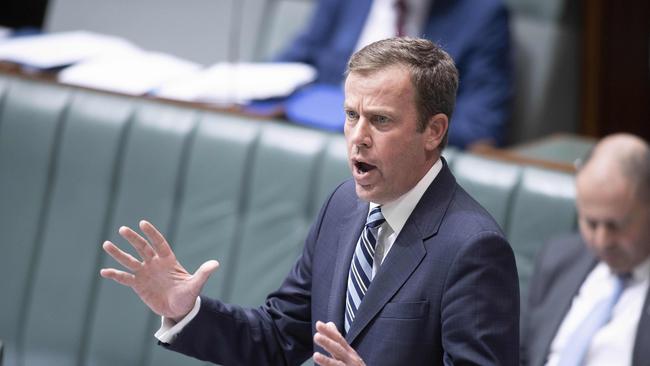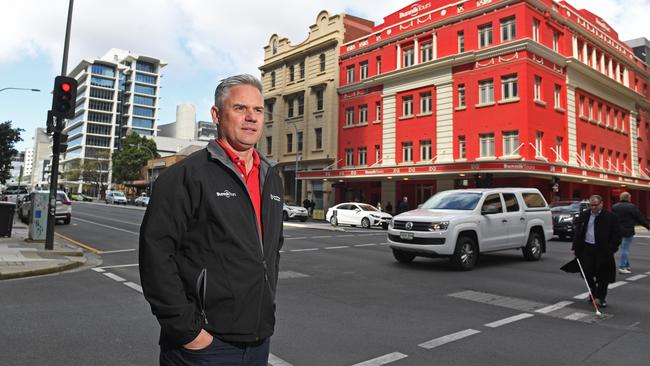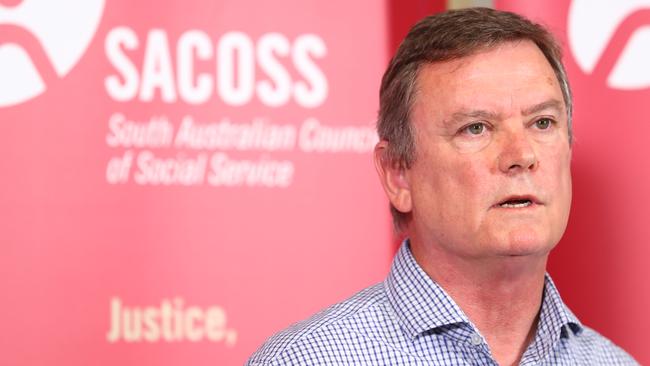Tourism jobs warning over JobKeeper cut-off
Workers in the tourism industry are likely to find their employment in peril when government payments to their bosses end, businesses say.
SA News
Don't miss out on the headlines from SA News. Followed categories will be added to My News.
One in five South Australian tourism-related businesses say they will need to cut staff once JobKeeper ends in March, a new survey has found.
And, about one in 12 tourism companies say they will be forced to close without the financial lifeline to pay their staff, a Tourism Industry Council of SA survey of almost 200 businesses found.
On a more positive note, 64 per cent said there would be no impact on their business when JobKeeper ended on March 28 – and another 7 per cent actually planned to hire more staff.
TiCSA chief executive Shaun de Bruyn said many tourism businesses were constantly fighting to stay afloat with no international tourists and fluctuating state border closures.
“Some businesses who previously targeted interstate and overseas visitors have been able to adapt their product offering to local visitors,” he said.
“This is certainly not the case for many, particularly our tour operators and attraction experiences.

“If some form of financial support is not offered beyond March 28 for impacted businesses, we will see significant business closures and job losses.”
Dennis Bunnik, joint chief executive of Bunnik Tours and chairman of the Council of Australian Tour Operators, will meet federal Tourism Minister Dan Tehan in Canberra on Wednesday to urge him to extend JobKeeper for the sector and provide additional targeted support.
“We all know that once borders reopen post-COVID there’s going to be a big travel boom,” Mr Bunnik said.
“In order for that to happen and for Australians to be able to travel safely at that time, we’re going to need a travel industry, and the only way we can do that is to try and maintain the skills we have left.
“The job losses that we’ve already had to date have been pretty massive.”

Tourism businesses, hotels, motels, cafes, restaurants, clubs and bars remain some of the most deeply hit by the pandemic restrictions and border closures.
Accommodation and food services payroll jobs were 11.6 per cent lower in mid-January for SA compared to March last year, Australian Bureau of Statistics data shows.
There were 12.2 per cent fewer agriculture, forestry and fishery payroll jobs in SA in mid-January compared to March 2020, and 11.7 per cent fewer arts and recreation services jobs.
Finance Minister Simon Birmingham has warned “not every job has or can be saved”

‘Disaster’ looms for unemployed
By Michael McGuire
Tens of thousands of South Australians could be facing “extreme hardship” if the Federal Government fails to either extend the JobSeeker coronavirus supplement or lift the basic rate of the safety net after March 31.
Uniting Communities manager advocacy Mark Henley predicts the financial pressure will not be felt immediately, but will increase as rents became due and utility bills needed to be paid.
“There will be quite extreme hardship build up over the next two, three, four months,” he said.
Last year, the Federal Government introduced a $250 a fortnight coronavirus supplement that was then reduced to $150 a fortnight.
On April 1, the JobSeeker payment will return to its pre-pandemic level of $565.70 a fortnight, or about $40 a day.
A number of voices have called for the Federal Government to increase the basic rate of JobSeeker, including Reserve Bank governor Philip Lowe and the Business Council of Australia.
According to the Australian Bureau of Statistics, the number of South Australians on JobSeeker and Youth Allowance increased from 78,421 to 117,216 between March and December. The nation’s unemployment rate is not expected to return to pre-COVID-19 levels until 2023.
SA Council of Social Service chief executive Ross Womersley said a “major disaster” was looming if the base rate of JobSeeker was not increased.
He welcomed the support of Mr Lowe and the Business Council.
“That speaks to the depth of consensus that this is an incredibly inadequate payment at this point in time,” Mr Womersley said.
He said the supplement had allowed people to enjoy the basics in life, such as putting decent foot on the table, and to attend to longstanding health issues, such as dentistry
“For people who are long-term unemployed, it meant for the first time in some years they were able to do things like go to the shops without fearing once they got to the checkout that they wouldn’t be able to pay,” he said.
Mr Womersley, who believed JobSeeker should be increased by $90 a week, said lifting the rate meant extra money would be spent in local communities, providing a direct economic stimulus for local businesses.
Prime Minister Scott Morrison was this week noncommittal to a permanent increase, only saying it was under consideration.
True test is yet to come
By Giuseppe Tauriello
Signs are emerging that the COVID-19 insolvency drought may be breaking, but fears of an impending tsunami of business collapses are subsiding.
However, the true test is expected to come later this year, once government stimulus measures, such as JobKeeper, come to an end.
ASIC figures show a second consecutive increase in the number of weekly insolvencies in the final week of January, rising to 72 appointments across the country.
It follows a 20-year low in the number of companies going into administration or liquidation last year, after the Federal Government introduced measures at the height of the pandemic to help struggling businesses stave off anxious creditors and remain afloat. Many of the emergency protections – including limiting statutory demands by creditors, giving companies more time to respond to creditors’ demands and removing personal liability for trading while insolvent – were phased out from January 1.
And while many feared a wave of debt-laden “zombie” companies, propped up by the temporary measures, would be killed off in the new year, that is yet to materialise.
Local insolvency experts say JobKeeper remains the key safety net keeping things together.
“From April through to the middle of the year is when I think we’ll start seeing an increase in activity,” Oracle Insolvency Services managing partner Nick Cooper said.
“Certainly for those in hospitality who are receiving JobKeeper, and also with the restrictions on landlords taking action against tenants, a lot of those businesses might be in for a bit of shock by the end of March.”
In South Australia, 231 insolvencies were reported in 2020, down 44 per cent from the previous year.
BCR Advisory director Stephen James said, come April, businesses would “again have to stand on their own two feet”.
“And depending on what type of business it is, and what type of landlord they have, they may have arrears of rent that accumulated during COVID, they may need to pay back loan repayments that have been deferred,” Mr James said. “Inevitably at some point there will be pressure … and logic says that there will be a catch up of insolvencies after last year’s drop.”
Cowell Clarke insolvency law specialist Peter Leech said it was important for small business owners to keep a close eye on their finances as they emerged from COVID-19.
Homeowners face crunch
By Valerina Changarathil
Thousands of homeowners and businesses are weeks away from increasing debt stress as COVID-19 repayment deferrals on closeto 118,000 loans, valued at $41.7bn, ends in March.
Latest figures provided by the Australian Banking Association show that the overall number is down substantially from theone million loan deferrals at the peak of the health pandemic in June last year.
Businesses were the fastest to get back on track, with only 6.6 per cent of business loans that were deferred still outstanding.
Home loan deferrals still make up a chunk of the loans on hold.
As of January 20, there were 15,039 business loan repayments on hold valued at $2.7bn and 90,695 home loans valued at $38.7bn.
Unsecured loans (personal, credit cards, etc.) totalled 12,252 and were valued at $321.6 million.
There were no state-level breakdowns by number of loans, but financial regulator Australian Prudential Regulation Authority(APRA) has been providing a monthly update on loan deferrals, which show SA’s share of housing and SME loan repayment deferralswas at 1 per cent at the end of December
“There’s no doubt that there’s still a long way to go, a lot of people are still experiencing real pain,” said Anna Bligh,ABA chief executive and former Queensland premier.
“I’d expect to see the deferral figure continue to come down. But there’s no sugar coating this, come March/April there aregoing to be business and households that are going to face some really tough decisions.”
She said banks were committed to working with every customer wherever they can to keep them in their homes and businesseswhere it’s in the customer’s interest.
“There are a lot of tools in the toolkit.”
Options would include potentially moving to interest-only repayments or restructuring loans in other ways to reduce repaymentstemporarily.
“What banks are working hard to do is to make sure there are as few casualties as possible after this pandemic.”
Australia’s largest bank CBA this week reported more than 70 per cent of its customers who had deferred the repayments ontheir home loan have now returned to their pre-deferral terms.
CBA has 25,000 home and 2000 business loans in deferral.
A spokeswoman for BankSA owner Westpac three quarters of the more than 145,000 mortgage customers it had assisted with homeloan deferrals have recommenced repayments. Additionally, 32,900 small business customers have been assisted with deferrals.
“Customers with ongoing financial challenges will receive tailored support on a case-by-case basis.”
A NAB spokesman said the bank had about 4300 home loans still deferred with total balances of $2.2bn at the end of Decemberalongside about 760 business loan deferrals of $0.73bn.
“While it is pleasing to see most of our customers have resumed repayments we know some customers will need our ongoing assistance,” he said.
“We will continue to provide support to these customers based on their individual circumstances.
“This may include reduced loan repayments, payment moratoriums, employment support, including resume and interview skills,and access to financial councillors.”
ANZ said it will provide an update on deferrals at its trading update on February 18.
It held the most frozen loans, at 3.1 per cent as of November 30, among the big four.



